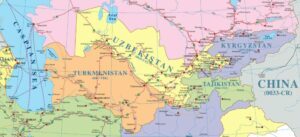Last month we made a check on the advancement of Chinese high speed network. Also Central Asia, a region of 4 million square km, 74 million of people and 500 billion$ of GDP, has several key railway projects aimed at enhancing connectivity, boosting trade, and promoting regional cooperation. They have been planned in 2021/2022 and are in progress notwithstanding the Ukrainian war and Pakistan tensions with Chinese infrastructures building.Here are some of the main railway projects:
“Trans-Caspian International Transport Route (TITR)”: also known as the “Middle Corridor,” this project connects China to Europe via Kazakhstan, the Caspian Sea, Azerbaijan, and Georgia. It aims to facilitate cargo transport and reduce transit times. The crossing of Caspian Sea puts challenges to local harbours to transfer the railway traffic to Baku port, already expanded and infrastructured.
“China-Kazakhstan Railway Projects”: numerous expansion and modernization projects are underway in Kazakhstan to accommodate increasing freight traffic from China, including new railway lines, upgrades to existing tracks, and improved logistics facilities. This will be the main alternative and with higher speed to Russian Transiberian railway, which is more northern and also in modernisation effort.
“Uzbekistan Railway Modernization”: Uzbekistan is working on significant upgrades to its railway infrastructure, including high-speed trains and improved freight logistic.”High-Speed Rail Projects in Uzbekistan”: Uzbekistan is developing high-speed rail links between major cities, like Tashkent, Samarkand, and Bukhara, to enhance domestic travel and tourism.
“Kazakhstan Turkmenistan-Afghanistan-Tajikistan Railway”: this project aims to link Turkmenistan’s railway network with Tajikistan and Afghanistan, improving regional connectivity and facilitating trade with South Asia.
“Kazakhstan-Turkmenistan Railway”: this line enhances connectivity between Kazakhstan and Turkmenistan, facilitating the movement of goods and people, along North-South direction, whereas the others are mainly focused on East-West direction.
“Kyrgyzstan Railway Projects”: although limited by geographic and orographic difficulties, Kyrgyzstan is looking into projects to improve its railway infrastructure, including potential links to neighboring countries.
“International North-South Transport Corridor (INSTC)”: this multimodal transport network aims to connect India, Iran, and Russia through Central Asia, including enhancing rail links within the region. This is the major North-South railway initiative, connecting Russia with Arabic Sea through Iran ports.
The dynamic of economic growth in the region is quite high, including the troubled Afghanistan, but the level of interconnection remains low also because mountains and deserts don’t help to build networks, and historical cultural differences remain high barriers.These projects are crucial for fostering economic development, regional integration, and international trade in Central Asia, mainly included in One Belt One Road Chinese initiative along the East-West connection needs. Goods from Central Asia are arriving also to Baltic harbours, substituting in Riga, Vetspils and Liepaia the Russian and Bielorussian sanctioned traffics.



